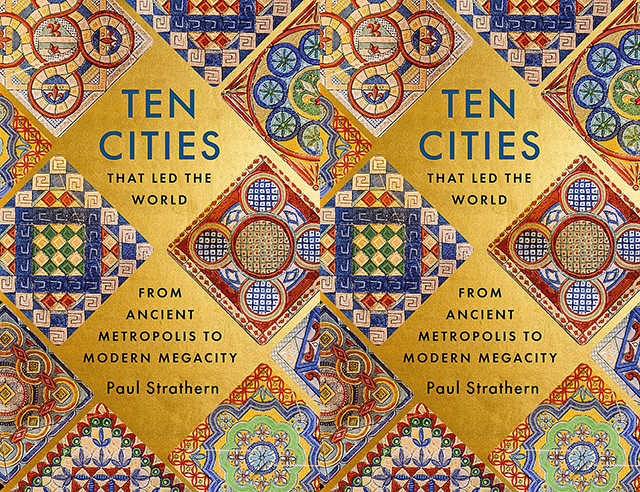Ten Cities that Led the World: From Ancient Metropolis to Modern Megacity
Book review

Ten Cities that Led the World: From Ancient Metropolis to Modern Megacity, Paul Strathern, Hodder and Stoughton, 2022, 260p, £25-00. ISBN 978-1-529-35934-2.
This book has such a level of coherence and insight that it will be read in a single session. Any book that manages to encompass the notion of L.P. Hartley that ‘the past is a foreign country, they do things differently there’; Voltaire’s observation on the execution of Admiral Byng that ‘il est bon de temps en temps de tuer un amiral pour encourager les autres’; and an assessment of Ai Weiwei’s aesthetic contribution to modern society will inevitably bring such a strong response from me.
In one sense this book is misnamed because, in reality, what Paul Strathern has done very powerfully is to identify and assess the contribution of ten major cultural and political entities to the development of human society. The path that he depicts is from Babylon to Beijing. Of course, in each instance a conurbation is at the heart of each section but what he presents is far more than just an observation on how specific urban populations have influenced human cultural and political development. To cite an example, what he says about Stalin’s Russia is extremely powerful but it is much more than just a comment on the role of Moscow.
In accepting his analysis and the development of his proposition that there has been a chronological progression from metropolis to megacity, in one sense it is essential to respect the quality of his depiction of the cultural and political significance of each example. These assessments are very carefully crafted and there is a cohesion in what he has argued. Otherwise, there would have been an argument about which cities should have been included if it had been a hierarchy of urban importance. On that alternative basis, Berlin and Amsterdam, both economic and political beneficiaries of Louis XIV’s expulsion of the Huguenots in 1685; or Vienna, by wide recognition a cultural beacon in Europe; or indeed the historical and cultural significance of Timbuktu, with its early libraries, as an example of African urban and cultural development, might have been included.
Equally instinctive Londoners, such as myself, would debate the chronological positioning of London in Paul Strathern’s sequence. Daniel Defoe, at the beginning of the eighteenth century, described London as the ‘Great Wen’. Many of us share Defoe’s appreciation of how a mass of villages and small towns had already grown together by that time to produce what some would say was the first conurbation, with all its local rivalries and pride. As early as 1180 the chronicler William FitzStephen, a monk at Canterbury, recorded that the London trade guilds were already so active that they were promoting football matches for local boys to provide them with a leisure pursuit, itself a sign of a very sophisticated mindset and, therefore, it was already a place with a distinctive urban character.
None of these observations are intended to diminish the potency of the proposition that Paul Strathern has offered us. Rather it is an indication of the wider cultural debate that this book will inevitably generate.
To gain a good sense of the philosophy behind this book, its prologue gives a strong perspective of the history of cities in a broad context, including the decline and disappearance of places such as Carthage and Knossos; and the final portion of the chapter on Beijing returns to this theme as a finishing flourish.

